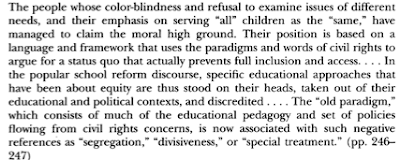Janzen, J. (2007). Preparing Teachers of Second Language Reading. TESOL Quarterly, 41(4), 707-729.
Joy Janzen, in her TESOL Quarterly article “Preparing Teachers of Second Language Reading,” examines the pedagogical instruction and philosophy used by six ESOL teachers in a small urban school district in the Midwestern United States. Janzen’s main purpose of the article is to examine reading and reading instruction, and the topics teacher educators should address in methods courses (Janzen, 2007). Before addressing the six main issues identified from Janzen’s research, identifying her methods of collecting information can help the reader see Janzen’s stream of consciousness concerning her article’s formation.
Over a two-year period of study, Janzen interviewed six teachers in the Midwestern United States school district, and scheduled 36 in-class observations of ESOL teachers and the instruction used in the classes. Gathering and analyzing the information from her two-year study, Janzen produced six important issues or concerns formulated from the ESOL teachers she interviewed and observed. Within each issue, Janzen reports on the results.
1. Working with a range of learner proficiencies.
In the section of results pertaining to working with various language proficiencies, Janzen identified two concerns and two useful methods. The two concerns were school scheduling and teacher availability to assist students individually. The school scheduling made it difficult for teachers to group students by level, and resulted with various language levels in the teachers’ classrooms, especially with secondary students.
Concerning the two useful methods, the author found cooperative learning and literature circles to help students of different academic levels work together and promote learning in the classroom. According to Janzen (2007), “types of cooperative learning have been used successfully with ELLs” (715). In addition, learning circles also provides students with a role or job within a group, which help promotes participation (Janzen, 2007).
2. The use of materials
When dealing with material, the author reports one important aspect is the selection of texts “that would either evoke the students’ prior knowledge or, at least, clearly support the text’s content” (Janzen, 2007). However, the interviewed and observed teachers reported that none of them “relied on a single series of texts” (714), but rather stole or modified from various sources to help the students form connections with their texts (Janzen, 2007).
Lastly, a teacher should continuously or periodically use assessment to “chart [the students] progress in reading and determine [the] placement into proficiency-based reading groups” (Janzen, 2007). By using a continuous or periodical style of assessment, a teacher will be able to efficiently insert necessary instruction to help the growth of their student’s education.
3. Instructional Practices in the areas of decoding skills, vocabulary, writing, and thematic teaching
When concerning developing decoding skills, the observed teachers reported that a consistent focus on decoding skills was beneficial in the lower grades; however, the teachers also reported that consistent decoding instruction was not necessary with secondary students (Janzen, 2007).
When concerning the development of writing skills, Janzen (2007) admits, “the complex ways in which writing and reading interact for ELLs are beyond the scope of this study” (716); however, she describes the importance of beginning writing instruction early, because early writing instruction can help activate prior knowledge abilities, understanding story structure, and demonstrating a student’s reading comprehension (Janzen, 2007). Some methods to accomplish the previous mentioned abilities utilize “graphic organizers, story retellings, reading logs, pre-reading journals, process writing techniques, and creative writing” (Janzen, 2007).
When discussing vocabulary development in Janzen’s article, she does not discuss or examine various vocabulary development methods; however, she gives the reader more of a warning: be careful of vocabulary ambitions, because school standards can crush them (Janzen, 2007). For specific vocabulary instruction, the Janzen suggest the use of vocabulary method texts.
Lastly, Janzen describes the importance of thematic teaching when helping ELLs obtain the target language; for example, Janzen (2007) cites information stating, “reasons frequently cited for using [thematic teaching or approach] agrees with those listed earlier: increased vocabulary learning and greater mainstream academic success because learning is contextualized” (717).
4. Developing students’ love of reading
When trying to motivate one’s students, many different techniques can help students see the enjoyment of reading. In Janzen’s article, she obviously points to the main element in getting students to enjoy reading, which is motivation. When sparking motivation in a student to enjoy reading, Janzen (2007) identifies a few techniques or methods: “materials, specific activities done with reading, explicit explanation of the value of reading, the use of extrinsic motivation...extensive reading, and providing a flood of books” (718).
5. Coping with mainstream teachers and school demands
In her article, Janzen discusses the difficulties the teachers had in their school. One major concern is being labeled as a reading teacher, when the teachers are ESOL teachers, or sending students to the ESOL classroom due to behavioral problems.
Another problem the ESOL teacher reported is instructional time with the students. Even though the teachers are teaching the same instruction regularly, ELLs “often [need] more time and assistance” (Janzen, 2007).
In addition, Janzen reports the teachers in her study perceive mainstream teachers not prepared to service ELL effective. Janzen support’s the teachers’ perception with a U.S. Department of Education National Center for Education Statistics. The survey states “45.5% of teachers in the state where this research took place reported teaching ELLS, but only 6.2% reported that they had had 8 or more hours of training in the last 3 years on how to teach ELLs” (Janzen, 2007).
6. Students’ Literacy and Oral Proficiency in their L1s
In the last section, Janzen reports the essential mastery of an ELL’s L1 (first language). Janzen notes many problems with ELLs and reading instruction comes from their illiteracy in their L1. When ELLs have education in their L1 and begin education in their L2 (second language), academic skills from their L1 can transfer to their L2 reading and other academic tasks; for example, some aspects are “literacy, extent of schooling, and oral proficiency” (Janzen, 2007).





